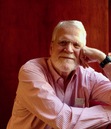Mark Scott Smith's Blog: Enemy in the Mirror, page 91
May 15, 2017
Das Volk Steht Auf – Jan 1945
THE PEOPLE STAND UP
In January 1945, as the Allies were closing in on the fatherland from the east and west, the director Veit Harlan released the historical film Kolberg to motivate Germans not to give in to the Allies. The film, based on the autobiography of Joachim Nettelbeck, mayor of Kolberg in western Pomerania, depicts the successful defense of the besieged fortress against Napoleon’s troops in 1807.

Gross Deutschland (Greater Germany) in 1937.
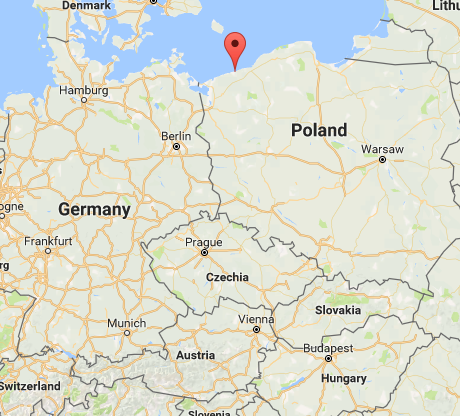
In March 1945, after two weeks of fierce German resistance, the city of Kolberg was taken by Russian and Polish forces.

The post Das Volk Steht Auf – Jan 1945 appeared first on Enemy in the Mirror.
May 11, 2017
Momotaro the Sea God Soldier – 桃太郎 海の神兵
This scene from Momotaro the Sea God Soldier (桃太郎 海の神兵), the first Japanese feature-length animated film, was directed by Mitsuyo Seo. Commissioned by the Japanese Naval Ministry, the film, released in 1945 by the Shochiku Moving Picture Laboratory, was a sequel to Momotarō no Umiwashi, a film released in 1943 by the same director.
Plot Summary paraphrased from Wikipedia: The film begins with animal sailors (a bear cub, monkey, pheasant, and puppy) rescuing a child from being swept downstream. Later, they clear a forest for an air base on a remote Pacific island with the help of the primitive jungle animals and teach them the alphabet by singing, washing clothes, giving military training and loading weapons onto warplanes.
Preparing for the invasion of the Indonesian island of Celebes (Sulawesi) , the monkey, dog and bear cub become parachute jumpers while the pheasant becomes a pilot. The paratroopers ambush a halftrack and invade a British fort whence panicked British soldiers agree to surrender to Japanese rule. A brief epilogue depicts children pretending to parachute onto a map of America drawn on the ground.
A notable musical scene in the film is the alphabet song AIUEO (アイウエオの歌) where Japanese soldiers teach the local animals how to speak.
_______________
I am impressed that North Korea today uses children in their propaganda posters and heroic animated characters in film – much in the same way as their oppressors of Imperial Japan did during WWII.


The post Momotaro the Sea God Soldier – 桃太郎 海の神兵 appeared first on Enemy in the Mirror.
May 8, 2017
Yalta Conference – Feb 1945

In February 1945, the “Big Three” President Franklin D. Roosevelt, Prime Minister Winston Churchill and Premier Joseph Stalin met at Yalta in the Crimea to:
demand the unconditional surrender of Germany
discuss the security and self-determination of liberated countries in post-Nazi Europe
discuss the conditions under which the USSR would enter the war against Japan
Although the European war against the Axis powers was coming to conclusion, the war in the Pacific was still raging. Consequently, the USA and Britain agreed that, in exchange for Soviet participation in the Pacific, the USSR would be granted a sphere of influence in Manchuria (including southern Sakhalin, Port Arthur and the Kurile Islands).
While Stalin initially agreed to allow free elections in Eastern Europe after the war, these agreements were soon cast aside with the onset of the Cold War. Although the People’s Republic of China ultimately gained control of Manchuria, the Kurile Islands remain in dispute between the USSR and Japan.
Controversy: Did the West sell out Eastern Europe at Yalta?
The post Yalta Conference – Feb 1945 appeared first on Enemy in the Mirror.
May 4, 2017
Dresden Firebombed – Feb 1945
From February 13-15 1945, British RAF and American USAAF heavy bombers dropped more than 3,900 tons of high-explosive detonation bombs and incendiary devices on the city of Dresden. The bombing and resulting firestorm destroyed most of the city center and killed ~22,700 to 25,000 people (although inflated casualty figures have often been cited).
Nazi propaganda following the attacks (claiming up to 200,000 casualties) and post-war discussions have seriously questioned whether or not the raids represented justifiable military action.
A 1953 USAF report justified the bombing, noting that Dresden was a major rail transport and communication centre, and housed 110 factories with 50,000 war industry workers. Critics of the bombing claim it was indiscriminate area bombing of a cultural landmark with little strategic significance.
Dresden before the firebombing of 1945

A central event in Kurt Vonnegut’s satirical book Slaughterhouse Five is the American POW protagonist’s survival during the Allied bombing of Dresden. Apparently, the description of the event in the novel is semi-autobiographical.
Excerpt from Kurt Vonnegut’s Slaughterhouse-Five : “It wasn’t safe to come out of the shelter until noon the next day. When the Americans and their guards did come out, the sky was black with smoke, The sun was an angry little pinhead. Dresden was like the moon now, nothing but minerals. The stones were hot. Everybody else in the neighborhood was dead…So it goes…”
The post Dresden Firebombed – Feb 1945 appeared first on Enemy in the Mirror.
May 1, 2017
Cabanatuan Raid – Jan. 1945
In January 1945, 511 emaciated Allied soldiers (mostly survivors from the fall of Bataan and Corregidor) and a few civilians were held at a Japanese prison camp, near Cabanatuan on the Philippine island of Luzon. After 33 months of brutal captivity, the majority of these POWs were severely emaciated.
After receiving reports that the Japanese intended to murder or move them as the Allies advanced, a daring raid behind enemy lines was carried out by U.S. Army Rangers accompanied by elite Alamo Scouts and Philippine guerillas.
~ 523 Japanese were killed or wounded in the successful raid at cost of two Rangers killed, and seven injured. All but one of the 511 American and Allied POWs were rescued.
The post Cabanatuan Raid – Jan. 1945 appeared first on Enemy in the Mirror.
April 27, 2017
Chenogne massacre – Jan. 1945
The January 1945 massacre of ~60 German POWs near the Belgian village of Chenogne by American troops was one of the war crimes committed by both sides during the bitter Battle of the Bulge. Carried out shortly after the German SS massacre of U.S. troops at Malmedy, the events were initially covered up and none of the perpetrators were prosecuted.

The post Chenogne massacre – Jan. 1945 appeared first on Enemy in the Mirror.
April 24, 2017
Battle of Luzon -January 1945

From January-August 1945 the Allies fought a land battle against Japanese forces on the island of Luzon. Although the Allies had control of all strategically and economically important locations of the island by March, pockets of Japanese resistance held out in the mountains until the unconditional surrender of Japan in September 1945.
The Battle of Luzon resulted in ~200,000 Japanese combatants dead (mostly from starvation and disease), 10,000 American combatants killed, and between ~130,000 Filipino civilians and combatants killed.
The post Battle of Luzon -January 1945 appeared first on Enemy in the Mirror.
April 20, 2017
Execution of Pvt. Slovik – 1945
This haunting scene from the 1963 film The Victors depicts the Christmas Eve execution of a GI deserter modeled after Private Eddie Slovik.
Private Eddie Slovik was the first American soldier since the Civil War to be executed for desertion. A draftee, Slovik was originally classified 4-F because of a prison record (car theft), but later reclassified 1-A when draft standards were lowered to meet growing army needs.
In August 1944, trained as a rifleman, Slovik was sent to France with the 28th Infantry Division, a unit which had suffered massive casualties in France and Germany. Lost in the chaos of battle as he approached the front line, Slovik was was turned in to U.S. military police by a Canadian unit. Reunited with his 28th Division in Belgium, no initial charges were brought, as replacements getting lost was not considered unusual.
Slovik, however, claiming he was too scared to be a rifleman, ran away. When he subsequently returned, he signed a confession of desertion and submitted it to an officer who advised him to rescind it, as the consequences could be dire. But Slovik refused and was confined to the stockade. Refusing a deal offered him to return to combat immediately and avoid court martial, Slovik was convicted of desertion and sentenced to death.
A last appeal to the Supreme Allied Commander came, inopportunely, during the Battle of the Bulge and Eisenhower upheld the death sentence. Private Slovik was then executed by a 12-man firing squad in eastern France.
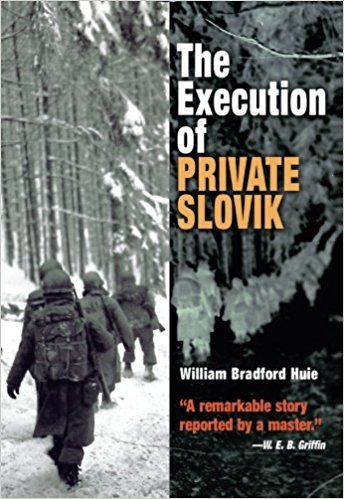
The Execution of Private Slovik was written by William Bradford Huie in 1954.
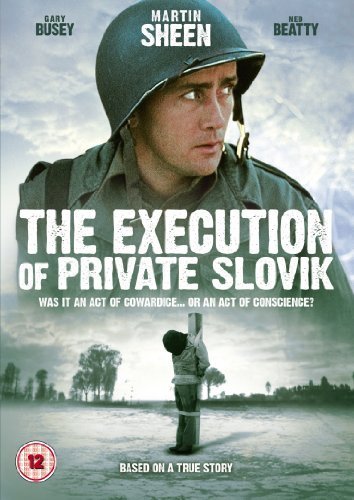
Broadcast on TV in 1974, as Americans were confronting their withdrawal from Vietnam, The Execution of Private Slovik, starring Martin Sheen, Gary Busey and Ned Beatty, became one of the most-viewed made-for-TV movies in American history.
The post Execution of Pvt. Slovik – 1945 appeared first on Enemy in the Mirror.
April 17, 2017
Firebombing Japan – 火災爆撃
Colonel Curtis Emerson LeMay designed and implemented an effective, but highly controversial incendiary bombing campaign against Japanese civilians in the final stages of the Pacific War.
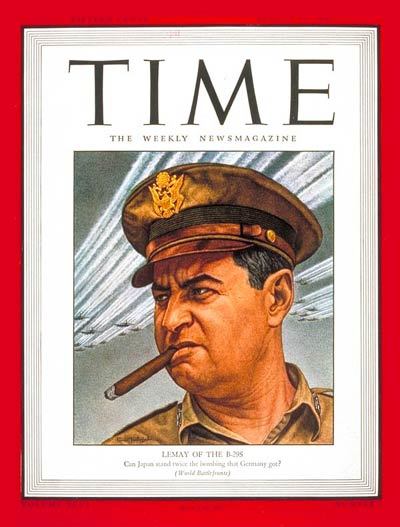
In December 1944, LeMay was transferred from China to assume command of the USAAF XXI Bomber Command. Given frequent cloudy weather and the powerful jet stream over the Japanese islands that often blew bombs off target, LeMay was convinced that high-altitude precision bombing was ineffective.
Japanese cities, largely constructed of combustible materials such as wood and paper, were highly combustible. LeMay therefore advocated high-altitude tactical bombing only when critical targets were not vulnerable to area bombing. Because daytime raids below the jet stream were extremely perilous, LeMay finally emphasized low-altitude, nighttime incendiary attacks on Japanese targets.
LeMay subsequently ordered massive incendiary attacks by B-29 Super fortresses on 64 Japanese cities. The most commonly cited estimate of Japanese casualties from the raids is 333,000 killed and 473,000 wounded.
The post Firebombing Japan – 火災爆撃 appeared first on Enemy in the Mirror.
April 13, 2017
Easter in Nazi Germany
In a 1939 census of Nazi Germany (including annexed Austria), 54% of Germans considered themselves Protestant, 40% Catholic, 3.5% gottgläubig (non-sectarian believers in God) and 1.5% as non-religious.

In the spring of 1936, Der Angriff, Berlin’s Nazi paper founded by Propaganda Minister Joseph Goebbels, proclaimed that the egg trade, one-fourth Jewish before the Nazis assumed power, was now Judenrein—free of Jews.
_______________________________________
Although some Nazi leaders (including Martin Bormann, Joseph Goebbels, Alfred Rosenberg, and Heinrich Himmler) were distinctly opposed to Christian churches, some such as Hans Kerrl, the Minister for Church Affairs pushed for a unique Nazi form of “Positive Christianity” which rejected the Old Testament and Jewish origin of the religion. The small pagan Deutsche Glaubensbewegung (German Faith Movement), which worshipped the sun and seasons, supported the Nazis.
Hitler’s plan to create a unified Protestant Reich Church failed, with strong resistance from Martin Niemöller, Dietrich Bonhöffer and members of the Confessing Church (Bekennende Kirche). Although a 1933 Concordat between the Third Reich and the Vatican promised to respect Church autonomy, all Catholic institutions whose functions were not strictly religious were closed and many Catholic clergy, nuns, and lay leaders were arrested over the ensuing years.
Jehovah’s Witnesses, Bahá’í Faith, Salvation Army, Christian Saints, Seventh Day Adventists, astrologers, healers and fortune tellers were all banned in Nazi Germany.
Source: Religion in Nazi Germany
The post Easter in Nazi Germany appeared first on Enemy in the Mirror.
Enemy in the Mirror
I began by posting events around the turn This website www.enemyinmirror.com explores the consciousness, diplomacy, emotion, prejudice and psychology of 20th Century America and her enemies in wartime.
I began by posting events around the turn of the 20th century as I was researching my first novel about the Pacific War. I continued through WWII for my second novel about the Battle of the Atlantic. Now I am beginning to look at the Cold War as I gather information for my next novel about the Korean War. ...more
- Mark Scott Smith's profile
- 7 followers


